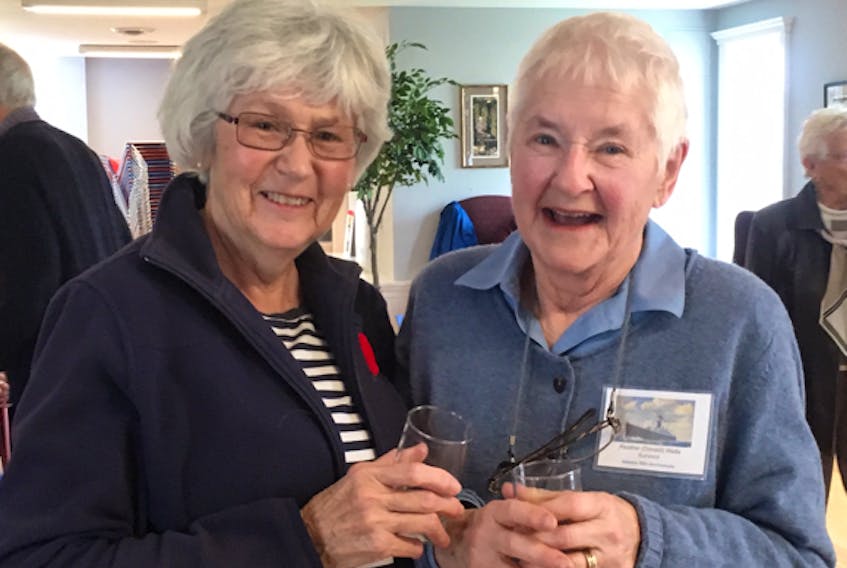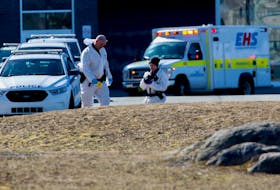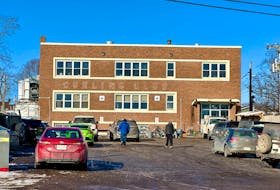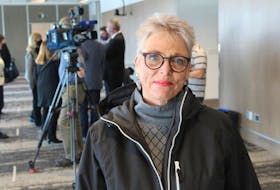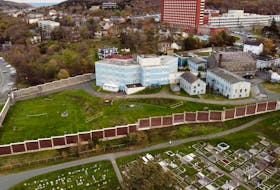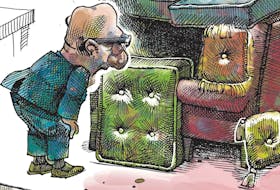WOLFVILLE, N.S. — Eleven years ago, Wolfville’s Heather Watts gave a talk about surviving a ship’s sinking in wartime. An article on her depiction made the recent reunion of the S.S. Athenia possible.
That article in The Advertiser in 2008 allowed family members to connect Heather with another survivor in Ontario, Vivian Collver. Eventually, they said to each other: “We’re probably not going to be around for the 100th anniversary of the sinking - perhaps we should try and commemorate the 80th in some way.” So, they started to plan.
The Halifax reunion of a group of survivors, none of whom had met before, led to some amazing storytelling.
Former Randall House curator Roger Marsters, who is at the Maritime Museum of the Atlantic, suggested an evening lecture on the anniversary. Heather adds, we knew that Tom Sanger, a journalist and writer in San Diego, had just written a fictionalized account of the sinking, ‘Without Warning,’ which was based on real characters. As he was doing promotional tours, Sanger was willing to speak.
Then the hunt was on for survivors.
Heather said that the Riverside Museum in Glasgow, which has an Athenia exhibit, put them in touch with survivor Philip Gunyon in Ontario. Both Sanger and Dr. Francis Carroll of the University of Manitoba, the author of a non-fiction account of the sinking, sent contacts for survivors they had interviewed. With Gunyon as the third member of the organizing team, they emailed everyone they could, advertised on Facebook, on the CBC, and through the Maritime Museum. Vivian’s son-in-law, Scott Fraser, was a huge help with logistics, displays and transportation.
“To be honest we didn’t think that very many would be able to come to Halifax, based on our ages (you would have to be at least 82 to remember anything at all),” Heather said.
The survivors were spread across the continent, but nine made plans to attend.
Eighty years ago, on Sept. 3, 1939 Britain declared war on Germany. Heather, who was not yet three, and her mother were aboard the passenger liner when it left Glasgow that day.
Actually, there were 1,400 people on the vessel when the Athenia was hit by one torpedo off the Hebrides. More than 100 souls died in the tragedy.
The torpedo hit the port side near the stern, destroying the engine room, collapsing cabin walls on D deck, Heather noted, as well as the staircase to the higher decks. Water flooded into the passages and cabins in that section of the ship, which made it particularly difficult for children trying to escape.
She has few memories apart from those her mother recounted.
“My mother and I were very fortunate. We were in our cabin on the next deck up (from the blast), my mother reading a story to me, when the torpedo hit, and all the lights went out. There was what my mother described as “an almighty jolt” and the smell of an explosion.
They found themselves on starboard side of the ship, which listed higher out of the water after the torpedo struck and made launching their lifeboat difficult. The boat plunged the last seven feet into the water, throwing everyone into the stern and covering them with black engine oil and seawater. The sailors above were able to right it, but the lifeboat floated rudderless all night, requiring constant bailing with shoes or hats or anything available to keep the water below knee level. Fortunately, the weather seemed quite warm, the sea was not too rough, and porpoises played around the boat and dived beneath it.
Her mother finished the bedtime story.
They spent eleven hours drifting in that lifeboat.
Those who found themselves on that boat were largely unaware of what was happening to the others. In a couple of cases, she said, this was just as well because during the rescue, accidents cost many more lives.
Noreen Bigelow McKenzie of Drumheller, Alberta wrote how her father, rushing back from the dining room, had to dive repeatedly through chest-high water to find and pull her unconscious brother to the surface.
Scott Calder, whose father was the English butler of a wealthy family on Long Island, was part of a group of older children who were being read the classic story The Swiss Family Robinson on deck.
The impact of the torpedo knocked him backwards and sent him sprawling onto the deck, receiving a painful splinter in his bottom. Scott, one of the oldest of the survivors at the reunion, turned out to be the comedian of the group. He maintains that he was the first American casualty of The Second World War.
Altogether, six ships responded to the SOS messages that continued to be automatically transmitted giving Athenia’s location. The first ship to arrive, just after midnight, was the empty Norwegian freighter Knute Nelson. Three destroyers, an empty U.S. cargo ship and the Southern Cross, a small luxury yacht belonging to an Electrolux millionaire, answered the call.
Geoff Etherington, a 90-year-old survivor who came from Connecticut, had been with his mother in lifeboat #8 attempting to reach the Southern Cross. The worsening weather caused them to drift first closer, then under its projecting stern, which was pounding up and down with each new swell. Geoff jumped and his mother was tossed into the water. Finally mother and son were reunited on board the yacht, where hot soup and warm blankets awaited them.
Don Wilcox of Dartmouth, a teen at the time, learned how difficult it was at first for authorities to compile accurate survivor lists. His father, back in Montreal, saw a picture posted by the Montreal Gazette outside its offices and recognizing his wife and son knew for the first time that they were safe.
The last rescue ship to reach land, and the only one to land in North America, was the City of Flint with 235 passengers who didn’t want to return to Britain.
The sailors made shoes out of rope and canvas for little Cynthia and Vivian Hunt, who attended the reunion.
They recalled evening concerts where children and adults alike sang, danced, took part in limerick competitions and held hilarious fashion shows to pass the time. Everyone worked and everyone helped, under the strict and kindly eye of Captain Joseph Gainard and his crew. The passengers were met at Pier 21 by Premier Angus L. MacDonald and crowds of people.
MC for the reunion, Phil Gunyon paid tribute to the courage and presence of mind shown by his mother, who guided her three children under seven through that dangerous and terrifying night.
Separated from her family, Jacqueline (Hayworth) Bullock was taken in by another family close by and remained with them until their rescue ship reached Glasgow where her aunt met her. This happened many times, Heather said, as three quarters of the passengers on the Athenia were women and children. Lost or frightened children were temporarily looked after.
Heather said the survivors were grateful for the way their descendants listened, questioned and learned about the futility of war and its effects on the innocent. There was also a sense of closure for the survivors themselves.
Most had never met anyone who shared their experience.
Former Advertiser and Register reporter Wendy Elliott lives in Wolfville.

